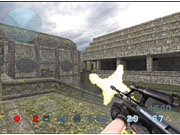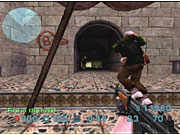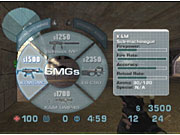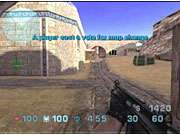Counter-Strike isn't just a game, it's a phenomenon. Originally created by a couple of college students as a downloadable mod for Valve's pioneering 1998 PC first-person shooter, Half-Life, Counter-Strike has more than outlived the game on which it was based and remains one of the most widely played online games in the world, despite being based on 5-year-old technology. Why did Counter-Strike take the world by storm? For one thing, it was free and piggybacked a game that had a huge installed base. But, more importantly, it combined realistic kill-or-be-killed gunplay in a highly competitive, team-oriented environment that featured an incredibly fast, perfectly tuned, arcadelike pace. Much like the way Street Fighter II pioneered the fighting game but was never truly surpassed, so will Counter-Strike remain the once and future king of team-based shooters. Now Microsoft, in partnership with Valve, has brought Counter-Strike to the Xbox, where it's no longer free and no longer as responsive, but, in other respects, is largely the same game as the PC version. It's a bare-bones product that's a missed opportunity, offering no compelling reasons to make it recommendable over the PC version, except to someone with an Xbox Live account and a completely outdated PC. On its own merits, it can make for some good fun online, but if you've never experienced Counter-Strike before, this new version may cause you to wonder what, exactly, all the fuss is about.

The mechanics and the pace of Counter-Strike are essentially intact here, and some new maps and the option to play with or against computer-controlled bots are the main, new attractions. The rules of the game are the same as ever. You'll participate in a series of brutal rounds, from the perspective of either a counter-terrorist (CT) or a terrorist (T), each attempting to thwart the other. Two types of mission objectives are available: demolition and hostage rescue. In the former, the Ts attempt to drop a bomb at a particular point and then try to defend it for a number of seconds before it goes off; the CTs can win by defusing the bomb and, thus, defeating the Ts. In the latter, the CTs must locate a pack of hostages and lead them to safety, but the Ts don't want that to happen. Either mission type has a popular alternate objective: Kill everyone on the opposing side.
Rounds tend to last only a few minutes--maybe three or four. By killing enemies or winning rounds, you earn money with which you may purchase better weapons, more ammo, armor, and grenades in the next round (all the money in the world won't help you against a better, faster CS player, though). One of Counter-Strike's key features, and one that has been copied by countless other multiplayer shooters, is that when you die during a round, you stay dead for the remainder of that round. This penalty, coupled with the relatively realistic damage modeling in the game (you can only withstand a few shots--if you're lucky and if you're wearing full Kevlar armor), forces you to forget about the sorts of gung ho heroics typical of other first-person shooters, and it, instead, forces you to stick with your team, keep your head down, and aim true.
The buy mode in the Xbox version of Counter-Strike is handled using a convenient radial menu, which gives you near-instant access to the game's variety of real-world equipment, including pistols, submachine guns, assault rifles, grenades, and other weapons . You have only a few seconds before the beginning of each round to get the gear you need, but it's enough time. You're able to buy gear during a round if you want, or you can grab a weapon from a dead friend or foe, but, for the most part, what you'll start the round with is what you'll end the round with. Realistically, Counter-Strike lets you carry a pistol, one larger weapon (like a submachine gun or a sniper rifle), a survival knife, maybe some grenades, and that's it.

Therefore, your primary weapon will dictate your main role in the round. If you're packing a sniper rifle, you don't want to meet an enemy with a submachine gun when rounding a corner. If you're packing a light machine gun, you don't want to be caught out in the open with it, but you should, instead, anticipate your enemy's advances and take advantage of the weapon's ability to shoot through certain solid materials, like wooden doors. High-explosive grenades and flashbangs, which can temporarily blind groups of foes, can be highly effective. Each weapon has its own unique properties, but none is overwhelmingly powerful. Also, there are some differences between the T and CT arsenals (for example, only the Ts get to use the equivalent of AK-47 rifles), but the two sides play pretty much identically. Counter-Strike for the Xbox offers no weapons that can't be found in the PC version, though it does feature some of the relatively new additions to the arsenal, like the CT riot shield.
In the PC version of Counter-Strike, the preferred combination of keyboard-and-mouse controls allows for incredibly responsive action, so that some particularly skilled players are able to take out their opponents almost instantly. On the Xbox, some of this precision is inherently lost due to the less accurate nature of having to use the dual-analog sticks for aiming and movement. This control scheme basically works fine and operates on the same principles as the PC version. For instance, your aim will be much better if you shoot while crouching in short, controlled bursts rather than laying on the trigger while running or jumping. However, the split-second reaction times rewarded by Counter-Strike are certainly limited by having to use a gamepad. Fortunately, you can adjust the sensitivity of the analog control (you'll probably want to bump it up at least a notch from the default). There's also a "quick turn" option, allowing you to rotate around much more quickly if you press in on the left analog stick. This quick turn is an essential ability in situations where the enemy manages to flank you. Additionally, you can easily cycle through your weapons by using the Y button.
Counter-Strike offers a rudimentary training mode, which is simply an offline match with some pop-up text explaining some of the gameplay elements. It's of little help, but, in reality, this is a fairly intuitive game that must be learned through practice. The single-player mode, exclusive to the Xbox version of Counter-Strike, is suitable for that purpose, at best. There are four skill levels--beginner, standard, professional, and expert--plus a fifth, custom difficulty option. The computer-controlled bots, of which you can have up to 11 in a match, perform with varying degrees of proficiency that are dependent on skill level. Additionally, the computer-controlled bots can make for some pretty good target practice. Interestingly, the bot AI isn't attempting to model the tactics of real-life terrorist or counter-terrorist squads, but, rather, the bot AI is attempting to model the habits of real-life Counter-Strike players. For instance, much like real players tend to do, you'll see your AI teammates switch to the knife at the beginning of a round to gain a slight boost in running speed. Sometimes the bots will hop around foolishly or "camp" a certain spot, which is also like some real CS players. Furthermore, the AI will attempt to follow some rudimentary orders, like following you or holding position, which may be issued by using the directional pad.

Ultimately, though, the bots aren't very competent about their primary mission objectives and are no replacement for playing with and against other humans. As if to acknowledge this, the entire single-player mode of Counter-Strike for the Xbox is identical to the multiplayer mode. There's no structure to it, and it's merely the same continuous sequence of action-packed rounds as you'd get online. You pick your skill level and one of the game's maps, and you're off. And, sure enough, if you're killed during a round, as in the multiplayer mode, you're out of the action until the round is over. Only here, you just have to wait for the AI to finish the job, and you can't observe or chat with your fellow human teammates. The Xbox version of CS retains the same "ghost" mode found on the PC version, allowing you, once killed, to watch the remaining players from a third-person perspective--or from their own first-person perspective (though, unlike in the PC version, there's no option to just fly around the map, detached from any of the players). The machinelike behavior of the bots becomes quickly apparent when looking through their perspectives, whereas in the online mode, getting to watch other players finish off a round is a decent consolation for getting gunned down before the round's conclusion.
Online, via Xbox Live, or using the Xbox's system link feature, Counter-Strike performs well. Hosted matches support a maximum of just 10 human players, unless you use your Xbox as a dedicated server, in which case 16-player matches are possible--excluding you. You may reserve any number of slots for people on your friends' list, you may choose to play humans versus bots matches, and you may customize a variety of other options if you wish. Game sessions can be set to have friendly fire on or off, and participants can be given the option to vote to switch maps at any time. Voice chat has been a popular feature of the PC version of Counter-Strike for a while and is predictably useful for coordinating teams. Counter-Strike plays great if you're fighting alongside your friends, using carefully choreographed strategies. But it's also fine when played with strangers, since you'll naturally want to stick with your teammates to improve your chances of survival.
Most of the game's maps are time-tested, theoretically presenting interesting, balanced challenges for both the T and CT sides. The new maps (seven in total) generally fit in well, too, and will quickly stand out to CS veterans long since familiar with the majority of maps to be found here. As well, though, some subtle tweaks to the classic maps will be noticeable and may even be intriguing to experienced CS players. Two additional maps, for a grand total of 20, are already available for download via Xbox Live. Overall, there are a significant variety of settings that offer just about every action-movie set piece you could think of. You'll find Middle Eastern city streets, a lavish chateau, an airport, some South American ruins, a bank, a swamp, a snow-covered city square, and numerous other locations that each offer various points of entry and ensure that both the T and CT sides have viable options for ambushing opponents. However, none of these environments are interactive, so, apart from their varied looks and layouts, they're basically all alike; each is quite compact and streamlined to encourage this game's brand of close-quarters battles. As is the case with most CS players, you'll probably find a handful of the maps naturally more to your liking than the rest.
At a glance, the no-frills, bare-bones production of this version of Counter-Strike is readily apparent. The visuals are touched-up from the PC version's, yet they're certainly not overhauled. Some of the textures in the environments are nice, but the level architecture itself is simple. The game runs at a consistent--but none-too-smooth--frame rate, which will throw off CS fans who are used to the silky smooth frame rates of the PC version. Some unsightly graphical glitches, such as very choppy death animations and the occasional floating corpse, are evidence of the game's home-brewed roots and this port's lack of polish. Weapon models and effects are plain, but the weapons don't even take the names of their real-world counterparts (just like the retail PC version of Counter-Strike, released a few years ago). The characters look fine from afar, and their animations aren't bad, but they're really nothing special. Amusingly, Counter-Strike still makes use of the same over-the-top blood effects found in 1998's Half-Life, leading to some surprisingly gory shoot-outs. Other than that, the most notable aspect of the visuals is just a small, subtle detail: In the outdoor maps, you'll notice that it's very difficult to see into the shadows when standing out in the open, though you'll see more clearly a moment after stepping into those shadows. The effect is that of your eyes having to adjust to different levels of brightness, and it's a decidedly realistic touch. Unfortunately, it isn't enough to make Counter-Strike a particularly good-looking game.

One of the most remarkable things about Counter-Strike, from around the time the PC version first started getting popular, was how its amateur developers completely redid not only the graphics of Half-Life but also the sound. And they did a superb job of it. Audio has always played a key role in CS, since each weapon has its own, distinctive report, and it's possible to hear the footsteps of players who are running--as opposed to inching--their ways forward. It's a testament to the original developers' efforts that Counter-Strike for the Xbox, despite recycling all of those five-year-old sound effects, still sounds pretty good. Actually, though, it's also pretty embarrassing that no one bothered to update this game's audio in the process of translating it to the Xbox. For what it's worth, there's a new effect for when grenades detonate near your character. You'll now hear a simulated ringing in your ears, though the effect isn't as convincing as comparable effects found in other, similar games.
Ironically, the biggest competition that this Xbox version of Counter-Strike faces is from itself. In particular, the new Counter-Strike must compete against the aging PC version of Counter-Strike that's still free, still widely played, and still runs faster than ever on today's average system. Meanwhile, judged solely on its own merits or against standards established by other Xbox shooters, this game has a very limited variety of modes of play (including barely any single-player component to speak of) and contains underachieving production qualities that will disappoint those expecting anything more than just a port of an old PC shooter. Despite all that and despite the suboptimal controls for a game demanding of down-to-the-pixel precision, the gameplay of Counter-Strike still shines through as a finely tuned combination of addictive arcade action and deeply strategic teamwork. It's too bad, though, that the underlying high quality of the gameplay isn't more readily apparent.